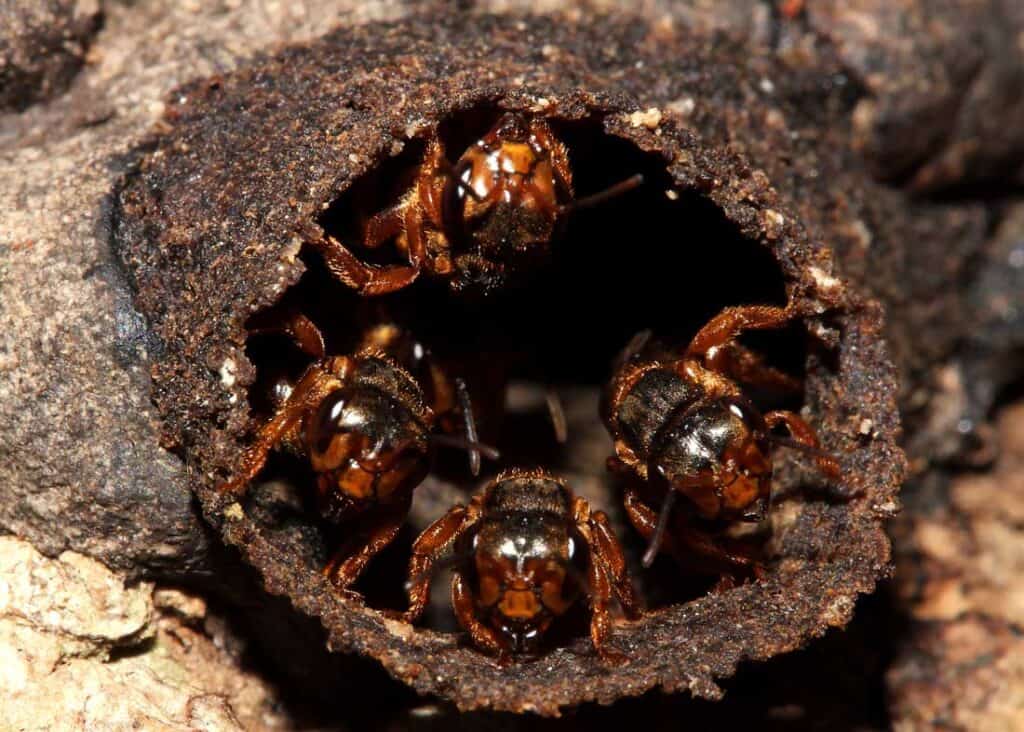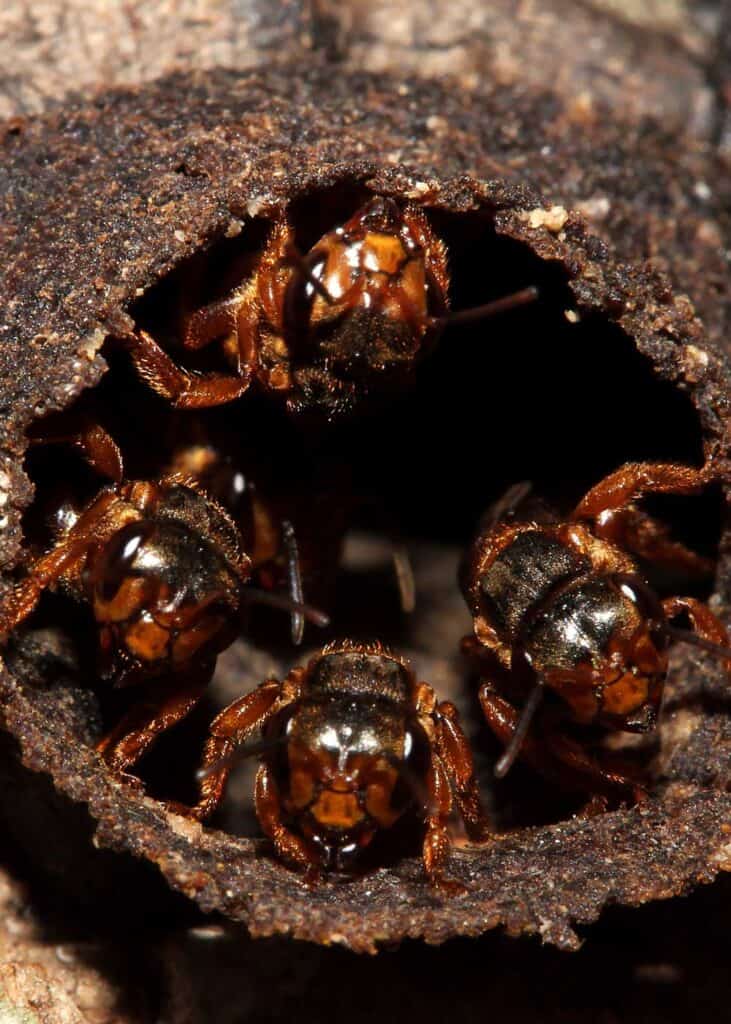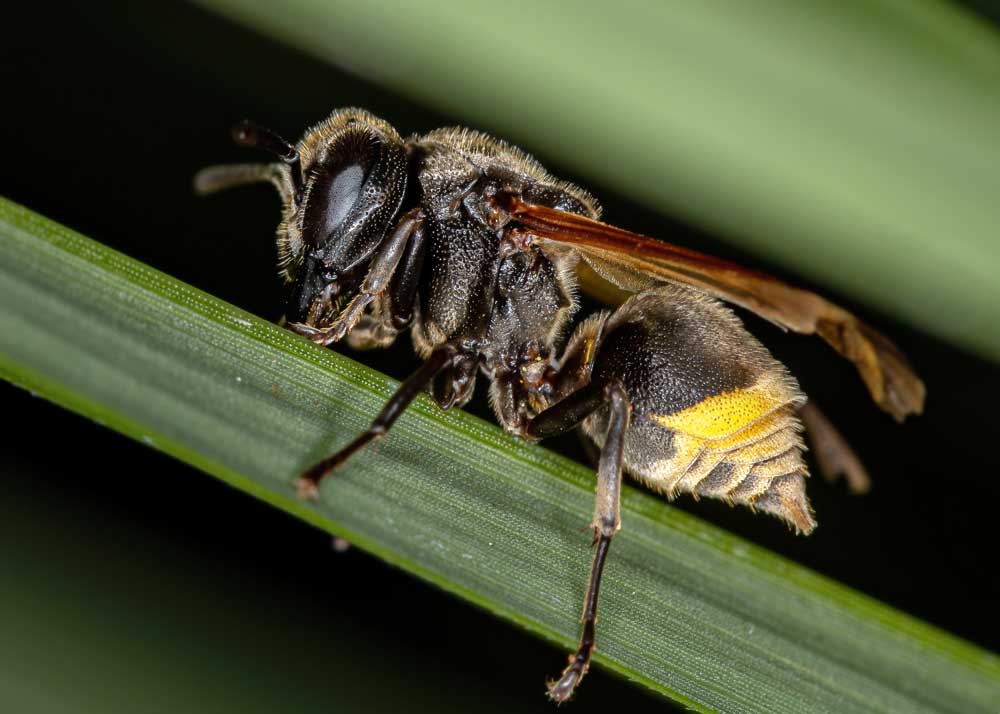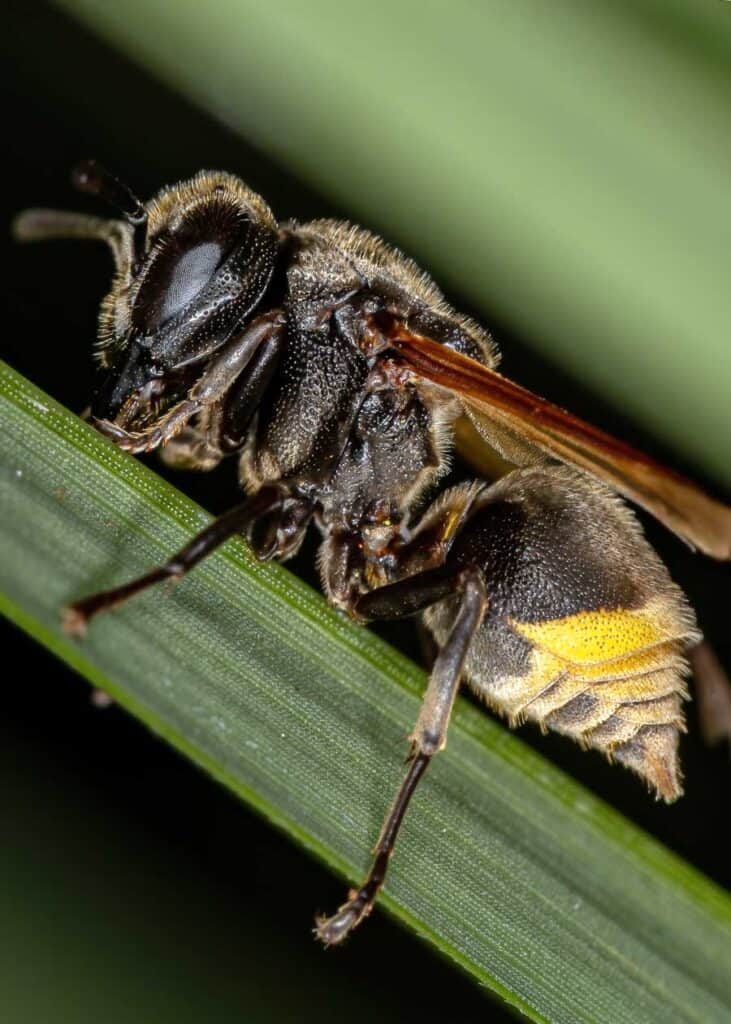For most people, the difference between bees and wasps is that bees make honey. What about wasps? Do wasps make honey? Generally, that distinction is true. But as with much in the animal kingdom, there are exceptions.
Generally, wasps don’t make honey. But they like honey, so wasps will steal it from beehives. There are a few species of honey wasps (Brachygastra genus) that do make honey. Most notably, the Mexican honey wasp and a dark paper wasp. Both honey wasps are found in Central and/or South America.

Table of Contents
Do Wasps Make Honey?
Of the estimated 100,000 wasp species, only a few make honey. The vast majority of wasp species do not make honey.
Most wasp species rely on hunting and scavaging for their food.
While adult solitary wasps primarily feed on nectar, they feed their young meat. Mostly insects and spiders feed the carnivorous young wasps.
Honey Producing Wasps
While most wasps don’t make honey, there is a genus (Brachygastra) of honey wasps.
As the name suggests, honey wasps are known for making honey.
The Brachygastra genus is made up of 17 species of social paper wasps.
Two of the better-known honey wasps include the Mexican honey wasp and Brachygastra lecheguana (a dark paper wasp). More on both of these below.
Where are Honey Wasps Found?
The majority of honey wasps are broadly distributed in the countries of Central and South America. The exceptions include Chile, Argentina, and Uruguay which have no known honey wasps.
Mexican honey wasps are found in southern Texas and Arizona.
Now, let’s learn about the two better-known honey wasps.
1. Mexican Honey Wasps
Mexican honey wasps are known by the scientific name Brachygastra mellifica.
Mexican honey wasps are the most famous honey-making wasps. They can be found from the southern United States (Texas and Arizona) and south as far as northern Panana.
As social insects, they prefer living in groups with other wasps and often build nests. The wasps mix their saliva with paper products in high trees to build nests that keep them safe from their predators.
Up to 18,000 wasps can live together in a single colony. And at 1/3 inches or less, Mexican honey wasps are quite small.
They have black and yellow stripes on their abdomens along with a dark thorax. They gather nectar, which they use to pollinate plants. In many areas, they have as many benefits as bees do.
Mexican honey wasps will occasionally feed on other insects, especially the Asian citrus psyllid. This pest can turn citrus fruits green and kill citrus trees.
Mexican honey wasps make honey that some compare to maple syrup because it’s so dark.

Did you know? What Eats Wasps? 37 Natural Predators
How Do Mexican Honey Wasps Make Honey?
They make honey in the same way that bees do.
These wasps grab nectar from plants and mix it with their saliva. They will also swallow the nectar and regurgitate it. This substance becomes honey.
Mexican Honey Wasps as a Food Source
Both the honey and larva of Mexican honey wasps are eaten, in communities like Los Reyes Metzontla, Mexico, a Popoluca town in Central Mexico.
This local delicacy is known as Panal Miniagua (Spanish), and Cuchii (Popoluca).
Interestingly, it is only harvested “when the moon is between its last quarter and waning gibbous” according to the Journal of Ethnobiology.
This is when the nests are most full of both larvae and honey.
What about hornets? Do hornets make honey? No, while hornets like to eat honey, they don’t make it.
2. Dark Paper Wasp (Brachygastra lecheguana)
This honey wasp is very similar to the Mexican honey wasp.
The range of this honey wasp is broader than its more famous counterpart. This wasp can be found from Mexico all the way south to Argentina. It has even been sighted in Texas and Arizona, although this is rare.
Their physical differences are limited to the width of the male reproductive anatomy.
B. lecheguana builds its nests closer to the ground than Mexican honey wasps. Its nest is often located in the undergrowth.
We don’t have a common name for this wasp in English. It is most commonly referred to as B. lecheguana.
7 Common Names for B. lecheguana
Here are the common names for the dark paper wasp in Spanish, Portuguese, and Kwaza.
- marimbondo-do-campo: Marimbondo is Portuguese for Wasp. Campo is Portuguese and Spanish for Field.
- marimbondo-do-pasto: Pasto is Portuguese for Pasture
- marimbondo-exu
- marimbondo-de-pote
- marimbondo-de-purrão: Empurrão is Portuguese for Push. Purrão is Portuguese for Jerk.
- avispa-de-pote: Avispa is Spanish for Wasp. Pote is Spanish for Pot.
- tu: Kwaza language, Rondônia, Brazil
This honey-producing wasp was formerly known as Nectarina lecheguana.
In addition to honey-making, B. lecheguana is also an effective predator. They favor beetles and the coffee leaf miner. It also favors the fruit of the Brazilan cherry and the African cherry tree.

Experts Weigh In (Incorrectly)
Here are a couple of experts who have stated unequivocally that wasps don’t produce honey.
- When asked “do any wasps make honey?” Luis Villazon (Zoologist) answered: “No. Adult wasps drink nectar from flowers but don’t turn it into honey.”
- David S Chadwick (Entomologist) didn’t do much better. He responded “NO … Wasps do not in fact store anything.”
As already discussed, these answers are incorrect. As most animal lovers know, exceptions are the rule in the animal kingdom.
What Do Wasps Eat?
So if wasps don’t make honey, what do they eat?
Wasps consume a diet high in fruit sugars and other insects and spiders. They usually go for fruits that have a high level of natural sugar, which is why farmers consider them pests.
Wasps are scavengers. While they eat nectar and fruits, they also consume living and dead bugs.
Some wasps are parasitic and mainly eat nectar, which they obtain from different plants. Parasitic wasps will also lay eggs in their prey. When the eggs hatch, the larvae slowly eat through the brain of the victim and come through its body.
Certain types of wasps also lay their eggs inside plants to ensure that their larvae have a constant food source.
Wasps Need Protein
Wasps require protein to survive.
Yellowjackets and bald-faced hornets are just a few of the types that will eat other insects to gain protein.
They catch spiders and grasshoppers along with beetles and caterpillars. In addition to living insects, wasps will also eat dead bugs if they are still fresh.
One of the reasons why bees can survive on nectar and pollen alone is that they have thick hairs on their legs.
When they land on a plant, they can pull pollen into their mouths, but the pollen will also cling to their legs. When they get back to their nests, they pull the pollen off their legs and mix it with the pollen collected in their mouths. Pollen is high in protein.
Wasps do not have those same hairs and cannot obtain enough pollen to survive and feed their colonies.
How do Wasps Use Their Mouths?
One thing you may not know about wasps is that they have strong jaws with powerful teeth.
When a wasp finds an insect in the wild, it will hold the bug in its mouth and bring it back to the colony.
The wasp uses its strong teeth to crush the prey into smaller pieces, which it feeds to its larvae.
What is the Lifespan of a Wasp?
While female bees can live for a year or longer, wasps have a much shorter lifespan.
While wasps have a queen, the other females in the colony are workers who are responsible for maintaining the nest.
- Workers usually only live for around three weeks because they spend so much time working and helping the nest.
- Drones are the wasps that go out into the world and bring back nectar to feed the others. These wasps can live for up to a month but usually don’t last much longer.
- The queen of the colony lays the eggs that become the workers and drones can survive for up to a year.
Do Wasps Eat Bees?
Wasps are one of the top predators to bees, especially yellowjackets. Not only will wasps collect dead bees to feed their young, but they may attack a beehive to get to the honey inside.
When their eggs hatch in the spring, the wasps can find enough food and sweets to feed their young. This changes as plants begin dying in the fall.
Wasps will go after bees for both the honey and the protein from the bees themselves.
Some wasps will bite through bees and just bring back the thorax for their babies. There are times when wasps will kill all of the bees in a hive and feed off both their bodies and their honey.
More reading: Wasp vs Bee vs Hornet (Identification Guide)

More Reading: Do Bumble Bees Make Honey? Key Differences
Wasps and Honey
Looking at do wasps make honey will show you that most do not. They find the sweet flavor they crave from bees who consume honey as well as the honey in beehives. The Mexican honey wasp found in the southern US and Central America is a famous wasp that makes honey.
- About the Author
- Latest Posts
Bryan Haines is a co-founder and writer at The Buginator. And is working to make it the best resource for taking back the outdoors from biting, stinging pests.
He also blogs about travel at Storyteller.Travel and photography at Storyteller Tech. Bryan is a partner at Storyteller Media, a publishing company he runs with his wife, Dena.
